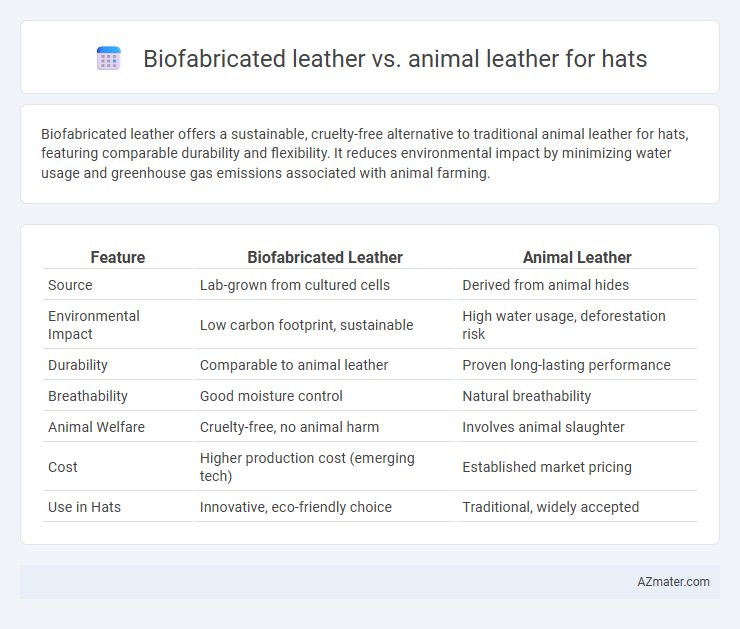Biofabricated leather offers a sustainable, cruelty-free alternative to traditional animal leather for hats, featuring comparable durability and flexibility. It reduces environmental impact by minimizing water usage and greenhouse gas emissions associated with animal farming.
Table of Comparison
| Feature | Biofabricated Leather | Animal Leather |
|---|---|---|
| Source | Lab-grown from cultured cells | Derived from animal hides |
| Environmental Impact | Low carbon footprint, sustainable | High water usage, deforestation risk |
| Durability | Comparable to animal leather | Proven long-lasting performance |
| Breathability | Good moisture control | Natural breathability |
| Animal Welfare | Cruelty-free, no animal harm | Involves animal slaughter |
| Cost | Higher production cost (emerging tech) | Established market pricing |
| Use in Hats | Innovative, eco-friendly choice | Traditional, widely accepted |
Introduction to Biofabricated and Animal Leather
Biofabricated leather is created through cellular agriculture, growing collagen fibers in labs to replicate traditional leather's texture without animal harm. Animal leather, sourced from the hides of livestock such as cows, undergoes tanning processes to enhance durability and aesthetics for hat production. Biofabricated leather offers sustainable and cruelty-free alternatives, while animal leather remains valued for its natural strength and established industry standards.
Material Origins: Biofabrication vs. Traditional Animal Leather
Biofabricated leather is derived from cultured cells or plant-based materials through advanced biotechnological processes, offering a sustainable alternative to traditional animal leather produced from cowhide or other animal skins. This innovative material eliminates the need for animal slaughter, reduces environmental impact, and streamlines the supply chain by using controlled lab environments rather than livestock farming. Traditional animal leather involves complex tanning processes that rely heavily on water, chemicals, and land resources, often contributing to deforestation and high carbon emissions.
Production Process Comparison
Biofabricated leather for hats is produced through cellular agriculture, where animal cells are cultured to grow collagen fibers without raising livestock, significantly reducing environmental impact and resource usage. In contrast, animal leather involves conventional tanning processes that require animal hides, extensive water consumption, and chemical treatments to prepare the material, contributing to pollution and deforestation. The scalable production of biofabricated leather offers a more sustainable and ethically responsible alternative to traditional animal leather in hat manufacturing.
Environmental Impact: Sustainability and Resource Use
Biofabricated leather for hats significantly reduces environmental impact by minimizing land use, water consumption, and greenhouse gas emissions compared to animal leather. Animal leather production involves intensive livestock farming, leading to deforestation, methane emissions, and chemical pollution from tanning processes. Biofabricated leather offers a sustainable alternative with lower carbon footprints and efficient resource utilization, supporting eco-friendly fashion choices.
Durability and Performance in Hat Making
Biofabricated leather offers superior durability and consistent performance for hat making due to its engineered fiber structure that resists wear and maintains shape under various conditions. Animal leather, while traditionally preferred for its natural flexibility and breathability, is prone to cracking and degradation over time when exposed to moisture and UV light. The controlled production of biofabricated leather ensures uniform thickness and strength, making it an ideal material for long-lasting, high-performance hats.
Aesthetic and Sensory Differences
Biofabricated leather for hats offers a smoother, more uniform texture and can be customized in color and finish to achieve a modern, sleek aesthetic, whereas animal leather presents natural grain variations and rich patinas that develop uniquely over time. The sensory experience of biofabricated leather tends to feel lighter and cooler to the touch with consistent suppleness, while animal leather often provides a warm, tactile richness with slight imperfections that add character. Both materials differ in aroma; biofabricated leather lacks the distinctive organic scent of animal leather, which can evoke a traditional, rustic appeal.
Ethical Considerations and Animal Welfare
Biofabricated leather offers a sustainable alternative to traditional animal leather by eliminating the need for animal farming and slaughter, thereby significantly reducing animal cruelty and promoting animal welfare. This innovative material is produced through cellular agriculture or plant-based methods, minimizing environmental harm associated with livestock production such as deforestation, greenhouse gas emissions, and water usage. Choosing biofabricated leather for hats supports ethical fashion and aligns with growing consumer demand for cruelty-free and environmentally responsible products.
Cost and Market Availability
Biofabricated leather for hats offers a cost advantage over animal leather by reducing expenses related to livestock farming, such as feed, land, and labor, while benefiting from scalable production methods that can lower prices as technology advances. Market availability of biofabricated leather remains limited but is rapidly expanding due to increasing demand for sustainable materials and investments in biotech startups, contrasting with the well-established supply chains and extensive distribution networks of traditional animal leather. Consumers seeking eco-friendly hat materials may currently face higher prices and less variety with biofabricated leather, yet improving manufacturing efficiencies promise more competitive pricing and broader market presence in the near future.
Consumer Perceptions and Trends
Consumer perceptions highlight increasing interest in biofabricated leather for hats due to its sustainable and cruelty-free attributes, appealing to eco-conscious and ethical buyers. Animal leather remains valued for its traditional craftsmanship, durability, and luxury appeal, especially among premium market segments. Market trends indicate a growing shift towards biofabricated alternatives driven by environmental concerns and innovation in material technology, influencing hat manufacturers to diversify product offerings.
Future Prospects in Hat Industry
Biofabricated leather offers a sustainable alternative to traditional animal leather, reducing environmental impact and addressing ethical concerns within the hat industry. Innovations in biofabrication technologies improve material durability and aesthetic versatility, making it a viable option for high-quality hats. The growing consumer demand for eco-friendly fashion supports the future integration of biofabricated leather, potentially transforming production standards and market dynamics in hat manufacturing.

Infographic: Biofabricated leather vs Animal leather for Hat
 azmater.com
azmater.com